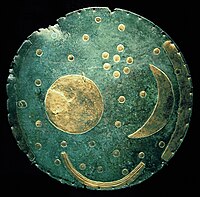| Millennium |
|---|
| 2nd millennium BC |
| Centuries |
| Timelines |
| State leaders |
| Decades |
| Categories: |
|
Births – Deaths Establishments – Disestablishments |
The 17th century BC was the century that lasted from 1700 BC to 1601 BC.

Events

- c. 1700 BC: Indus Valley civilisation comes to an end but is continued by the Cemetery H culture.
- 1700 BC: Belu-bani became the King of Assyria.
- c. 1700 BC: Minoan Old Palace period ends and Minoan Second Palace period starts in Ancient Greece.
- c. 1700 BC: beginning of the Late Minoan period on Crete.
- c. 1700 BC: Aegean metalworkers are producing decorative objects rivaling those of Ancient Near East jewelers, whose techniques they seem to borrow.
- c. 1700 BC: Lila-Ir-Tash started to rule the Elamite Empire.
- c. 1700 BC: 1450 BC: Young girl gathering saffron crocus flowers, detail of wall painting, Room 3 of House Xeste 3, Akrotiri (prehistoric city), Thera, is made. Second Palace period. It is now kept in Thera Foundation, Petros M. Nomikos, Greece.
- c. 1700 BC: Bronze Age starts in China.
- c. 1698 BC: Lila-Ir-Tash the ruler of the Elamite Empire died. Temti-Agun I started to rule the Elamite Empire.
- 1691 BC: Belu-bani, the King of Assyria died.
- c. 1690 BC: Temti-Agun I, the ruler of the Elamite Empire, died. Tan-Uli started to rule the Elamite Empire.
- 1690 BC: Libaia became the King of Assyria.
- c. 1680 BC: Egypt: Development of leavened bread (date approximate).
- c. 1673 BC: Sharma-Adad I became the King of Assyria.
- c. 1661 BC: Iptar-Sin became the King of Assyria.
- c. 1655 BC: Tan-Uli, the ruler of the Elamite Empire, died.
- c. 1650 BC: Collapse of the 14th Dynasty of Egypt.
- c. 1650 BC: Conquest of Memphis by the Hyksos and collapse of the 13th Dynasty of Egypt.
- c. 1650 BC: Start of the 15th (Hyksos) and 16th Dynasties of Egypt.
- c. 1650 BC: Possibly, start of the Abydos Dynasty in Upper Egypt.
- c. 1646 BC or earlier: Jie of Xia is overthrown by Tang of Shang (ca. 1675-1646 BC) in the Battle of Mingtiao.
- 1649 BC: Bazaia became the King of Assyria.
- 1633 BC – May 2 – Lunar Saros 34 begins.
- 1627 BC: Beginning of a cooling of world climate lasting several years recorded in tree-rings all over the world. It may have been caused by one, or more, volcanic eruptions e.g. the Minoan eruption of Thera, the Avellino eruption of Mount Vesuvius, and/or the eruption of Mount Aniakchak in Alaska.
- 1625 BC: Samsu-Ditana becomes King of Babylon (middle chronology).
- 1621 BC: Lullaia becomes the King of Assyria.
- 1620 BC: Mursili I becomes King of the Hittite Empire (middle chronology).
- 1615 BC: Shu-Ninua became the King of Assyria.
- c. 1600 BC: Tang of Shang established the Shang dynasty.
Deaths
Extinctions
- The last known population of woolly mammoth, preserved on Wrangel Island, becomes extinct.
Sovereign states
See: List of sovereign states in the 17th century BC.
References
- "NASA - Catalog of Lunar Eclipses in Saros 34". eclipse.gsfc.nasa.gov. Retrieved 2021-05-01.
- LaMarche, Valmore C. Jr.; Hirschboeck, Katherine K. (1984). "Frost rings in trees as records of major volcanic eruptions". Nature. 307 (5947): 121–126. Bibcode:1984Natur.307..121L. doi:10.1038/307121a0. S2CID 4370382.
- Baillie, M. G. L.; Munro, M. A. R. (1988). "Irish tree rings, Santorini and volcanic dust veils". Nature. 332 (6162): 344–346. Bibcode:1988Natur.332..344B. doi:10.1038/332344a0. S2CID 4286911.
- Vogel, J. S.; et al. (1990). "Vesuvius/Avellino, one possible source of seventeenth century BC climatic disturbances". Nature. 344 (6266): 534–537. Bibcode:1990Natur.344..534V. doi:10.1038/344534a0. S2CID 4368499.
- McAneney, Jonny; Baillie, Mike (2019). "Absolute tree-ring dates for the Late Bronze Age eruptions of Aniakchak and Thera in light of a proposed revision of ice-core chronologies". Antiquity. 93 (367): 99–112. doi:10.15184/aqy.2018.165.
- Stuart, Anthony J; Sulerzhitsky, Leopold D; Orlova, Lyobov A; Kuzmin, Yaroslav V; Lister, Adrian M (2002). "The latest woolly mammoths (Mammuthus primigenius Blumenbach) in Europe and Asia: A review of the current evidence" (PDF). Quaternary Science Reviews. 21 (14–15): 1559. Bibcode:2002QSRv...21.1559S. doi:10.1016/S0277-3791(02)00026-4.
| Centuries and millennia | |||||||||||||||||||||||||||||||||||||||||||||||||||||||||||||||||||||||||||||||||||||||||||||||||||||||||||||||
|---|---|---|---|---|---|---|---|---|---|---|---|---|---|---|---|---|---|---|---|---|---|---|---|---|---|---|---|---|---|---|---|---|---|---|---|---|---|---|---|---|---|---|---|---|---|---|---|---|---|---|---|---|---|---|---|---|---|---|---|---|---|---|---|---|---|---|---|---|---|---|---|---|---|---|---|---|---|---|---|---|---|---|---|---|---|---|---|---|---|---|---|---|---|---|---|---|---|---|---|---|---|---|---|---|---|---|---|---|---|---|---|
| |||||||||||||||||||||||||||||||||||||||||||||||||||||||||||||||||||||||||||||||||||||||||||||||||||||||||||||||